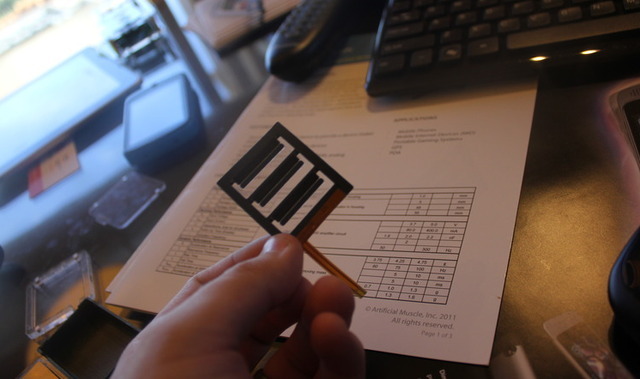
The most common form of force feedback in our electronic devices is the sort of rumbling buzz you get when a motor spins some sort of mass inside the case of your hardware. Video game controllers usually have two motors, one on each side of the controller, and that sort of "rumble in stereo" configuration allows for a number of effects based on the speed of each motor. This takes power, it takes space, and there's not much you can do with the technology. At CES I met with Artificial Muscle, a Bayer MaterialScience company, so they could show me their Vivitouch technology. Vivitouch a sort of artificial muscle that could changing how we experience haptic effects in our devices.
The Vivitouch device is small, almost perfectly flat, and after playing through a few demos using a consumer device that's available now, I was turned into a believer. That thin piece of plastic in the image above produces a rumble effect that's more responsive, subtle, and expressive than the technology that's currently the market standard.
The haptic effects in this case are created by a "dialectric elastomer film" sandwiched between two layers of electrodes. The electrodes contract when electric current is introduced, causing movement. You still need mass in order to give the player a satisfying feeling of movement and rumble, and in most of the devices we saw—such as a concept cell phone and a modified iPad—the mass was supplied by the device's battery. Vivitouch is able to use the existing components of the device to create rumble, instead of the metal weights used by most game controllers and portable devices.
What's even better is that the technology is easy to apply once the hardware is installed. I played a series of tech demos on an iPhone where the feedback was created using sound cues from a game. When I rolled dice, it felt like I was holding a box that contained physical dice, not the sputtery rumble usually felt in an iPhone. I played a pinball game on a modded iPad that included one of these strips, and the rumble effect felt much more satisfying than what we're used to from our portable electronics. I was told that they could fake the effects very well using just audio information, but the company would also provide an SDK for developers so they could code even better effects into games and applications.

Right now this technology is more expensive than existing motors, so if a company is just looking for a brute force approach, this isn't the best option. What this version of haptic feedback excels at is sending more detailed and subtle information to the player, and that's where the extra cost is justified. I was able to play with an Xbox 360 controller that had been modded with Vivitouch's technology and during a few demos I was able to feel the rumble of a motor in a way that felt much more realistic. In this case the strip was located in the center of the rear of the controller, using the battery pack as the rumbling mechanism. That may sound like it leads to a jittery mess, but the rumble effects felt much more precise than the stock controller.

The cost of these strips will come down in time, and the benefits are many: the technology is smaller than existing motors, it requires less power, and the feedback offered by the rumble is much higher quality than what's currently available. It may take a little convincing for electronics manufacturers to look at a new way of offering force feedback, but Vivitouch has a compelling argument.
reader comments
46